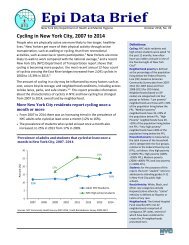2013-dot-sustainable-streets-lowres
2013-dot-sustainable-streets-lowres
2013-dot-sustainable-streets-lowres
Create successful ePaper yourself
Turn your PDF publications into a flip-book with our unique Google optimized e-Paper software.
tremendously positive responses. Demand for new publicspace and additional street safety improvements byelected officials and local stakeholders has filledproject pipelines to overflowing. New public spaces areheavily used throughout the Five Boroughs, as isSelect Bus Service wherever it has been implemented.Bicycle lanes are heavily used, with new routes in demandin many districts. Where professional pollsters haveasked New Yorkers to weigh in on new DOT initiatives,from pedestrianizing Times Square to CitiBike, theyhave without exception responded with large majoritiesin the affirmative.A major factor in winning public support has beenDOT’s innovative delivery of <strong>streets</strong>cape changes in theinfrastructure equivalent of real time. Where traditionalpractice wades through years or even decades ofplanning studies and trial balloons which take the publiccompletely out of the project development process, NYCDOT has pioneered the use of paint, planters and stoneblocks to redefine street spaces virtually overnight. Theproof of concept is not a computer model or engineeringstudy, but real world performance that can be observed,debated, refined and adjusted before being built–out withpermanent materials. This approach has changed urbanstreet planning and practice forever, in both rich and poorcities. Today, one can find painted road–beds transformedinto plazas or pedestrian safety areas in over a dozenU.S. cities, from Philadelphia to Los Angeles.Addressing transportation, traffic safety and otherchallenges on New York City <strong>streets</strong> is a set of tasks withno beginning or end. In addition to chronicling the changesand successes of NYC transportation programs since therelease of PlaNYC, this report looks ahead to future needsand issues. For example, as traffic fatalities and severecrashes become fewer in number, finding patterns thatDOT can address with its programs becomes a greaterchallenge. Public demand for improvements like Select Busroutes, slow speed school and residential zones, publicplazas, bicycle lanes and greater coverage for the CitiBikeprogram are increasing. Infrastructure funding, includingresources to replace temporarily defined street–spacewith permanent materials, is likely to be a persistentchallenge, as the federal government continues itsgeneral retreat from its historic role as a major source ofinvestment for roadways, bridges and mass transit, and asthe City adds disaster resiliency to its already considerablelist of priorities.The Bloomberg Administration and NYC DOT have shownthat updating and refocusing a large city’s transportationpolicy is possible and need not to take decades to carryout. This report presents the methods, practices, designsand results from the street policies implemented inNew York from 2007 to <strong>2013</strong>. We believe these methodsare highly replicable or adaptable to a wide variety ofurban contexts around the world, and invite the readerto consider the content here in that vein.In addition to the content presented in this document,DOT’s accomplishments can be viewed online at nyc.gov/<strong>dot</strong> and,in map format, at <strong>sustainable</strong><strong>streets</strong>.info.Sustainable Streets: <strong>2013</strong> and Beyond9



